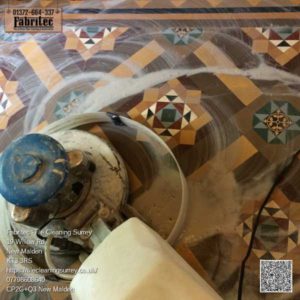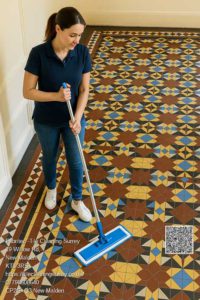Elevate Your Living Space with the Elegant Restoration of Victorian Tiles
Victorian hallway tiles not only infuse your home with a sense of historic charm but also necessitate consistent cleaning and maintenance to retain their captivating beauty. Renowned for their detailed designs and rich colours, these tiles epitomised 19th-century architectural splendour and continue to be highly sought after in contemporary homes. However, the wear and tear of time brings about specific challenges that require a careful and informed approach to their upkeep. With the right care, you can revive their original allure, ensuring that they perpetually enhance the essence and character of your living space.
Discover the Historical Importance and Cultural Heritage of Victorian Tiles
Victorian tiles transcend mere flooring options; they are remarkable historical artifacts that narrate a tale of exquisite craftsmanship from a bygone age. Constructed from resilient clay and adorned with stunning designs, these tiles encapsulate a rich legacy that warrants preservation. By engaging in the restoration of these cultural treasures, homeowners not only play a pivotal role in conserving history but also enhance the value and aesthetic appeal of their homes.
Recognising Typical Issues in Underappreciated Victorian Hallway Tiles
- Loss of Luster: A common challenge faced by neglected Victorian tiles is the accumulation of wax, a protective coating many homeowners apply to enhance shine and safeguard surfaces. Over time, this wax buildup can obscure the tiles, resulting in a dull and lifeless appearance. Improperly maintained wax traps dirt and dust, further dulling the vibrancy of the tiles and complicating the restoration efforts.
- Surface Imperfections: Without proper cleaning and care, scratches and discolouration can tarnish the surfaces of Victorian tiles. Frequently, this degradation stems from grit and dirt or harsh cleaning methods that erode the tile surface. The once vivid colours and intricate designs can become obscured, resulting in unsightly blemishes and a loss of the tiles' inherent charm.
- Decline of Original Appeal: One of the most disheartening effects of neglect is the loss of original allure in Victorian tiles. Each tile was meticulously crafted with attention to detail, designed to enhance the beauty of any room. Over time, neglect can lead to faded patterns and washed-out colours, making your space feel outdated and stripped of its historical charm.
Step-by-Step Guide to Expertly Restoring Victorian Tiles

Step 1: Effective Wax Removal Strategies
The initial phase of the restoration process entails the meticulous removal of layers of old wax using non-abrasive and tile-safe cleaning products that efficiently lift the buildup without harming the underlying tile surface. This step is vital for reinstating the tiles' natural brilliance and ensuring their longevity.
Step 2: Comprehensive Deep Cleaning to Restore Vibrancy
A professional deep cleaning procedure specifically targets stubborn grout lines, persistent stains, and ingrained dirt, unveiling the tiles’ original vibrancy. This crucial stage ensures that any discolouration is rectified and that the tiles are rejuvenated to their former glory, ready to dazzle once more.
Step 3: Implementing Robust Moisture Control Measures
Older properties frequently lack modern moisture barriers, rendering moisture control essential for tile longevity. We utilise dehumidifiers or breathable sealers to mitigate future moisture issues, guaranteeing that your tiles maintain their excellent condition for many years ahead.
Step 4: Sealing for Enduring Protection
In the final step, we apply a breathable impregnating sealer that shields the tiles from moisture and stains, assuring long-term durability while preserving their stunning appearance. This critical phase is indispensable for safeguarding your tiles' quality over time.
Crucial Maintenance Guidelines Post-Restoration
-
1. Select pH-Neutral Cleaners for Optimal Care
When caring for your Victorian tiles, it's imperative to choose suitable cleaning products that preserve their appearance and protect the sealant. pH-neutral cleaners are specially formulated to gently cleanse surfaces without stripping the sealer or damaging the tiles. These gentle solutions will not contribute to abrasion, discolouration, or fading over time.
Recommended pH-Neutral Cleaners for Victorian Tiles:
- LTP Wash – Ideal for regular cleaning without compromising the integrity of the sealant.
- Fila Multisurface Cleaner – A gentle yet effective solution perfect for maintaining tile surfaces.
2. Establish a Consistent Cleaning Routine to Prevent Accumulation

Even after the restoration process, dirt, dust, and grease can accumulate over time. Establishing a consistent cleaning routine is essential to prevent such buildup, ensuring your tiles remain visually appealing. Regularly sweeping or vacuuming to eliminate dirt and debris, followed by mopping with a damp cloth, will keep the tiles clean and lustrous.
- Tip: Utilise a microfiber mop for gentle yet effective cleaning that avoids scratching the tile surface.
3. Avoid Abrasive Tools and Harsh Chemicals
When caring for Victorian tiles, it’s crucial to refrain from using abrasive brushes, harsh scrubbers, or chemical cleaners that may harm the sealant or scratch the tile surface. Abrasive tools can create unsightly marks, dulling the shine and rendering the tiles more susceptible to wear.
Items to Avoid When Cleaning:
- Steel wool pads
- Bleach or ammonia-based cleaners
- Abrasive scrubbing brushes
Instead, opt for soft, non-abrasive sponges or cloths to maintain the tiles' pristine condition.
4. Address Minor Wear and Tear Immediately
Over time, minor wear and tear on your tiles is inevitable, but there are effective strategies to manage these issues without compromising the overall finish. If you spot small stains or areas that resist removal with regular cleaning, it is crucial to treat them promptly to avert further damage.
- Spot Cleaning: For stubborn stains, gently rub the area with a mild cleaner and a soft cloth.
- Surface Scuffs: Minor scuffs may often be buffed out using a microfiber cloth. For more persistent marks, applying a thin coat of sealer can restore the finish.
Tip: Don’t delay addressing spills. Staining liquids like wine, coffee, or oil can quickly penetrate, making removal significantly more challenging later.
5. Reapply the Sealer Regularly for Lasting Protection
While the initial restoration includes sealing the tiles, it is advisable to reapply the impregnating sealer every few years, contingent on foot traffic and wear. The sealer provides a vital layer of protection against moisture, dirt, and grime, which could otherwise infiltrate the tiles and cause damage.
Steps to Effectively Apply Sealer:
- Ensure the surface is completely clean and dry before reapplying the sealer.
- Apply the sealer in thin, even coats, allowing each layer to dry thoroughly before proceeding with the next.
- Pay special attention to high-traffic areas to ensure they receive adequate protection.
The Advantages of Engaging Professional Victorian Hallway Tile Cleaning Services
While some homeowners may contemplate DIY restoration, enlisting a professional tile restoration service typically yields superior results. Professionals possess the necessary equipment, expertise, and knowledge to manage the delicate nature of Victorian tiles, ensuring a successful restoration with minimal risk of damage.
Tile restoration experts can offer:
- Comprehensive cleaning and restoration services specifically designed for Victorian tiles.
- Expertise in moisture control and sealing techniques to safeguard your tiles from future damage.
- Professional guidance on effective long-term maintenance for your tiles.
If you're contemplating restoring your Victorian tiles, seeking professional assistance can significantly improve the outcome.
Need Expert Assistance? Hire the Professionals
While DIY cleaning is an option, hiring a professional guarantees that no damage is inflicted on the original surface of your tiles.
Frequently Asked Questions About Victorian Hallway Tile Cleaning
What is the Recommended Cleaning Frequency for My Victorian Hallway Tiles?
Light cleaning should be conducted weekly, with deep cleaning and resealing every 1–2 years, influenced by foot traffic levels.
Can I Use Bleach or Vinegar on My Victorian Tiles?
Absolutely not. These substances can erode the tiles and damage the sealant. Stick to employing only pH-neutral cleaners for optimal care.
Is Wax Removal Necessary Before Sealing?
Indeed, removing wax is critical to ensure that sealers adhere correctly and provide enduring protection for your tiles.
Should I Hire a Professional for Tile Restoration Services?
For the best results and to mitigate the risk of accidental damage, hiring a professional is highly advisable.
The Enduring Allure of Victorian Hallway Tiles
Victorian hallway tiles are beautiful historical pieces that, with proper cleaning and maintenance, can remain stunning for generations to come. Whether you are restoring a property in Chertsey or merely refreshing your hallway, investing in the care of these unique floors is invariably a prudent choice.
The Article: Uncover the Shocking Transformation of a Neglected Victorian Hallway In Chertsey first appeared on https://tilecleaningsurrey.co.uk
The Article Victorian Hallway Tiles Cleaning Chertsey: How to Restore & Maintain Timeless Floors first appeared on https://fabritec.org
The Article Victorian Hallway Tiles Cleaning: Restore and Care for Timeless Floors Was Found On https://limitsofstrategy.com

